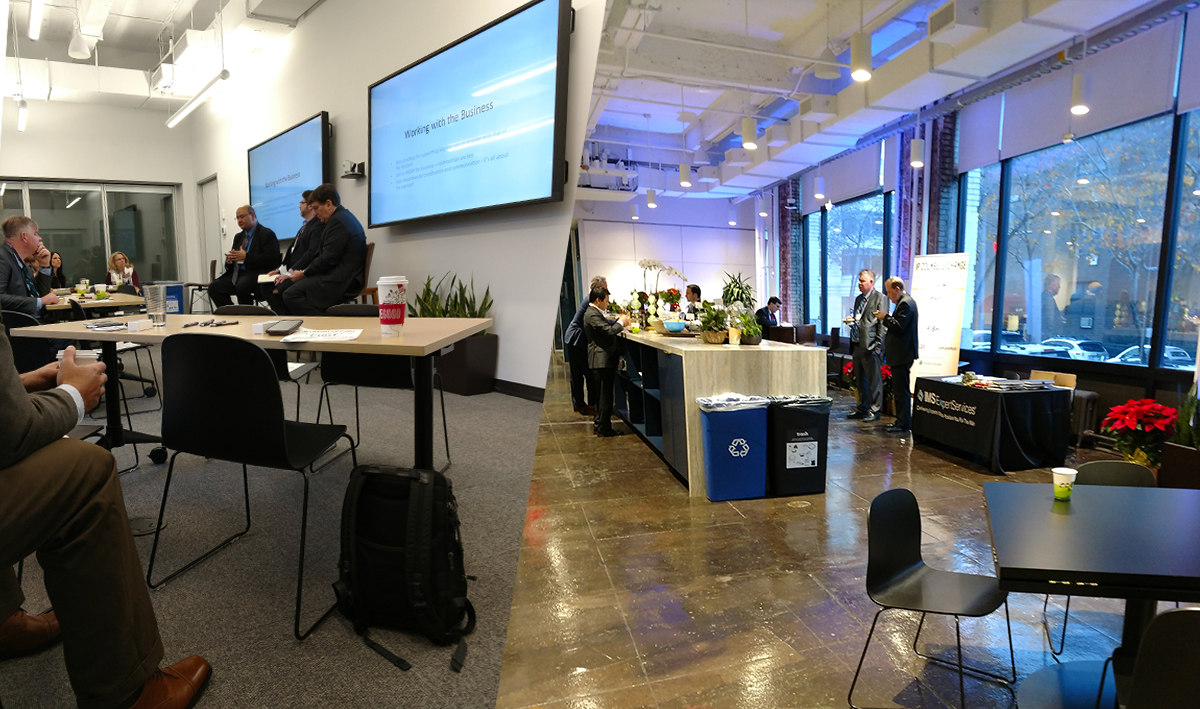
ktMINE’s IP Strategy & Valuation lead, Eric Podlogar participated at IP Counsel Exchange on December 7th in New York City. To highlight the successful and innovative strategic alliance between Wolters Kluwer and ktMINE, Eric, along with Wolters Kluwer’s IP specialist, Michelle Virzi, presented a demonstration of the new solutions developed specifically for IP legal professionals.
The Exchange gathered in-house IP counsel and featured presentations on key topics including the alignment of IP to business strategy; winning strategies for achieving success at the PTAB; and an examination of Section 337: the ITC.
The Business of IP: IP Alignment to Business Strategy – Best Practices and Recommendations for Crafting a Patent Prosecution & IP Licensing Strategy
The discussion began with general insights to consider when planning an IP strategy. One important point to keep in mind is that “products do not support IP”. It is actually the other way around: IP supports an innovative environment that enables the full development of a product.
Additionally, Doug Hudson, Assistant General Counsel of Etsy remarked that “Every patent you file is a press release”, and each filing provides a reflection of your strategy, whether you intend it or not. These considerations illustrate that an IP strategy goes hand-in-hand with a business and marketing strategy.
The discussion quickly turned to patent filing strategies: One method suggested was to initially file an application in the US, and then follow up with a filing outside of the US, depending upon the specific target. This would help mitigate any major setbacks caused by modifications to the filing during prosecution within the patent offices and may negate any strategic advantages. Some entities file directly into the PCT, which is a bit more expensive. That said, a prosecution cannot be US-centric anymore. Germany, for example, is a target for prosecution because of its favorable injunction rulings. Europe also has attractive unfair competition laws.
In the long run, entities are using analytics to determine the playing field. From a monetization strategy perspective, while patent pools and other similar arrangements are valuable, bilateral engagements such as collaboration agreements are seen as very effective options. The audience is prompted to provide insights while reviewing your patent portfolio and how to determine which assets to ditch and which to keep. One tip suggested to analyze by portfolio segments: “Look at the low-hanging fruit and determine what old patents you can sell; where the maintenance of the patents outweighs the value to your company.”
5 Years In, Beyond Nuance to Strategy: Winning Strategies for Achieving Success at the PTAB – Lessons Learned from the Front Lines of the PTAB Bar
IP Counsel Exchange was founded to address issues related to the new PTAB forum, so this topic was particularly relevant. It was learned that means-plus-function (“M+F”) claims are less likely to be rejected during a PTAB trial. This is because the patent infringer must present evidence invalidating the claim and it is more difficult to address an M+F claim mainly due to its tedium. Counsel must work through each claim and then provide examples of prior art. For an M+F claim, this means pulling information from the claim itself as well as information from the description. This work is very time-consuming, and because of the large number of words needed to properly process the argument, word limits are quickly approached. There are a number of tactics employed by counsel to shortcut the analysis:
- Performing analysis on one M+F claim, and then announcing that the analysis is similar to the remaining claims. The courts do not care for this shortcut and may reject the argument entirely.
- Use pictures to shorten the argument and avoid any word limitations (“A picture is worth 1000 words”).
In a rare win for patent owners, the use of M+F claims construction provides a distinct advantage in PTAB proceedings. It may be too early to determine if prosecution strategies have shifted to account for this advantage.
An Examination of Section 337: The U.S. International Trade Commission – Going Beyond Patent Litigation
Hon. F. Scott Kieff discussed the complicated structure of the U.S. International Trade Commission (ITC). Essentially, this commission encourages a “plurality of voices” exchanging ideas. There is no “black box” jury notice, and any discussions must occur in “sunshine” or not at all, so transparency is ensured.
There are essentially five groups associated with the commission:
1. First, there are six commissioners, each with their own legal teams; Three from each party with a rotating chair.
2. Next, there is a legal team representing the ITC as a whole.
3. There is a separate legal team that represents the interests of the public.
4. (&5.) Finally, there are two other legal teams representing each side of the issue.
These decisions typically wrap up within 18 months, which is far shorter than most other district-level assertions. It should be noted that the ITC handles more than just patent issues. It may also explore Tax and Transfer pricing issues.
The ITC remedies are statutory and not equitable (‘the law is the law’). It is entirely possible that the entity bringing the assertion may also be investigated for an ITC violation as well, depending on the context of the initial assertion.
With respect to the president weighing in on ITC decisions: Presidents normally weigh in with a “preference”, and not an outright order (which may be challenged in court). The analogy cited was that of “ice cream”: While the president “likes” ice cream, he may “prefer” vanilla over chocolate. In a real-world context, President Obama “preferred” that Apple not be served with an injunction on its iPhone products.
Upcoming Webinar Featured by IP Counsel Exchange
ktMINE and Wolters Kluwer will hold a webinar on Thursday, March 1st at 2 PM EST/ 1 PM CST / 11 AM PST that follows the discussions at the Exchange while showcasing their new IP research and analytics solutions for IP legal professionals.




